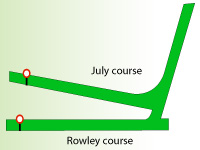Newmarket Racecourse
Introduction
Newmarket’s two racecourses lie in the home of the British horseracing headquarters, in the Suffolk town of the same name. The Rowley Mile Course is used for racing in the Spring and Autumn months whilst the July Course is used during the summer. Both courses are used for flat races.
History
When King James I left Scotland for Newmarket in 1605 he quickly recognised that he could cater for his great equestrian interest by establishing a racecourse on Newmarket Heath. However, it wasn’t until 1622 that an official race recording was made when, on the 18th March, a horse belonging to the Marquis of Buckingham became the first recorded winner at Newmarket, earning his owner £100 in the process.

Newmarket Racecourse
During the reign of Charles II, Newmarket became a leading venue for racing due to the King’s own interest in the sport. The King was known to be a keen rider himself and after recognising the difficulties caused by the late summer sun when racing he had a new course set up. He named this course the Rowley Mile Course after his own favourite horse, Old Rowley.
In 1665 Charles II declared that the Town Plate race would be run every year at Newmarket and had it decreed by an Act of Parliament. The first race took place a year later and is still run today, establishing the Town Plate as the world’s oldest surviving horse race.
In 1750 the Jockey Club was set up at Newmarket to govern horseracing in England. The elite group published a detailed list of rules governing all racecourses. The Jockey Club moved to London in the 1960s but still has rooms on Newmarket High Street.
Newmarket established a fixed fixture list during the second half of the 18th century, many of which still exist today.
The start of the 19th century saw the inauguration of the first two British classics: the 2,000 Guineas in 1809 and the 1000 Guineas just five years later in 1814.
Newmarket in the 20th Century
Newmarket’s July course played host to all of Britain’s classic races during the first and second World Wars due to all other racecourses being used for war purposes. This included Newmarket’s Rowley Mile course, which was used as an RAF base.
Throughout this period, Newmarket pioneered a number of new developments in the racing world. 1929 saw the introduction of the Tote, 1949 saw the first use of a photo finish while starting stalls were first used in 1965 at Newmarket.
Modern Day Newmarket
Since the turn of the millennium, Newmarket has seen a number of developments to its ageing facilities including the opening of the Millennium Grandstand to mark the beginning of the 21st century. In 2007 a £10million redevelopment plan was put into action to improve and modernise the facilities based behind the stands on the July Course.
Racecourse Information
Rowley Mile Course
This course has a straight of one mile and two furlongs but can be extended to two miles and two furlongs to form the Cesarewitch Course. The straight dips before the final 200m uphill finish, which is a real test of a runner’s stamina.
The July Course
Like the Rowley Mile this course can be extended to become a Cesarewitch course whilst all races under a mile long run along the final straight, which is known as the Banbury Mile.
Course Location
Newmarket Racecourses
Westfield House
The Links
Newmarket
Suffolk
CB8 0TG
Directions
By Road
The course can be accessed via the major cities in East Anglia on the A11 and A14. If driving from outside East Anglia, the M11 and A1/M1 can all be used.
By Rail
There are regular services running from London’s King Cross and Liverpool Street stations to the nearest railway station, which is Cambridge. A subsidised coach service is provided by Newmarket Racecourse that collects from Newmarket Town Centre, Cambridge Station and Stansted Airport.
Ticket Information
There are three main areas on race days:
Members
Tickets range from £18-£35 and guarantee the best view of the Winning Post. Smart dress is compulsory. Denim, t-shirts and trainers are all unacceptable in the members’ area.
Grandstand and Paddock
Tickets range from £13-£20 and dress is slightly less formal with smart shorts and denim allowed.
Family
Tickets cost between £5-£7. Neither the Winner’s Enclosure nor the Parade Ring can be seen from the family area. Casual dress is the norm.
Tickets can be purchased via the ticket section on the Official Website
Contact Information
General Enquiries: 01638 663 482
